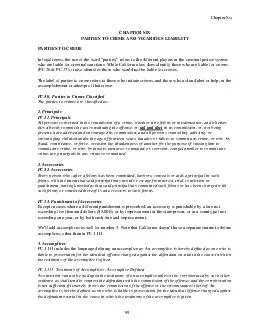/


While Califor nia law does identify those who are liable for crimes PC 26 PC 27 it also identifies those who would not be liable for crimes The label of parties to crime refers to those who initia te crimes and those who aid and abet or help in the ID: 34344
Download Pdf The PPT/PDF document "Chapter Six CHAPTER SIX PARTIES TO CRIME..." is the property of its rightful owner. Permission is granted to download and print the materials on this web site for personal, non-commercial use only, and to display it on your personal computer provided you do not modify the materials and that you retain all copyright notices contained in the materials. By downloading content from our website, you accept the terms of this agreement.
Chapter Six CHAPTER SIX PARTIES TO CRIME AND VICARIOUS LIABILITY PARTIES TO CRIME In legal terms, the use of the word “parties,” refers to 1. Principals PC 31. Principals All persons concerned in the commission of a crime, they directly commit the act constituting the offense, or aid and abet Every person who, after a felony has been committed, harbors, conceals or aids a principal in such felony, with the intent that said principal may avoid or escape from arrest, trial, conviction or punishment, having knowledge that said principal has such felony or convicted thereof, is an accessory to such felony PC 33. Punishment of Accessories PC 1111. Testimony of Accomplices - Accomplice Defined A conviction can not be had upon the testimony of an accomplice unless it be corroborated by such other Parties to Crime and Vicarious Liability ce Code, etc., there is also the California Jury Instructions regarding accomplices: Criminal or For example, CALJIC 3.11 Testimony of an accomplice must be corroborated. You cannot find a defendant guilty based upon the testimony of an accomplice unless that testimony is corroborated by other evidence that tends to connect such that defendant with the [Testimony of accomplice includes any out-of-court received for the purpose of proving that what the accomplice stated out-of-court was true.] Feigned Accomplices A “feigned” accomplice would be one who merely pretends or acts as though they were helping someone prepare to commit a crime, but their true motive is to help gain information to turn over to the police for prosecutorial purposes. Timing is everything, so you couldn’t wait until the police kick in the door and yell, “Freeze,” when you say, “Oh, I was just doing this to rat on so and so!” This brings up another issue “abandonment” or “renunciation.” Undercover officers actually would be examples of “feigned” accomplices since they have to ‘pretend” to be actively involved in the criminal endeavor. However, entrapment issues must be considered as well, since you would risk losing the case should that occur. ACTUS REUS OF ACCOMPLICE LIABILITY using a range of seemingly confusing terms such as “aid,” “abet,” “encourage,” and “command.” Whatever the terminology, keep in mind that the actus reus of accomplice liability is satisfied by even a relatively insignificant degree of material or psychological assistance. In California, the terms “aid,” “abet,” are used in the definition of a principal. In other words, an in California is treated the same as a , with only a cursory referral to an accomplice’s role in PC 1111. Note that the Penal Code does not refer directly to accomplices as a “party” to crime, yet there is a direct statute that holds accomplices accountable. The requirement for accomplice liability generally requires intent to assist in the commission of a specific crime. OF ACCOMPLICE LIABLITY A conviction for accomplice liability requires that a defendant both assist and intend to assist before, during or immediately after the commission of a crime. This requires proof that the defended knew, supported and assisted in the commission of a specific crime. ACCESSORY AFTER THE FACT Note these key points with accessories in California. The accessory comes only has already that the person is wanted by the police, and then knowing this, helps the person avoid arrest or escape from the police. In some states, there are “accessories” before the fact, accessory after the fact requires specific to prevent or interfere with an offender’s arrest, prosecution or conviction. VICARIOUS LIABILITY The term vicarious attaches liability to an act performed or suffered by one person as a substitute for another or to the benefit or advantage of another. An individual is held liable for the acts of another based on the relationship between the two parties. It typically is applied to crimes that do not require a criminal intent. Individuals may be held liable based on their relationship with the perpetrator of a crime. 100 Chapter Six Review Questions: If a “red light” camera photographed your license plate, but failed to record your face, would you still be liable for the citation? What would your options be? How could failure to follow the jury instructions from CALJIC harm a case? If you were drag racing with a friend, and a pedestrian was run over by him, would you be liable? Give an example of vicarious liability in your workplace. Define the key differences between an “accomplice” and an “accessory” to a crime? Web Resources http://dictionary.law.com/ 103